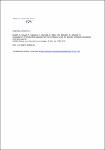Development of Antibodies against Anthrose Tetrasaccharide for Specific Detection of Bacillus anthracis Spores
Kühn, Andrea
Kovac, Pavol
Saksena, Rina
Bannert, Norbert
Klee, Silke
Ranisch, Heidrun
Grunow, Roland
Methods for the immunological detection of Bacillus anthracis in various environmental samples and the discrimination of B. anthracis from other members of the B. cereus group are not yet well established. To generate specific discriminating antibodies, we immunized rabbits, mice, and chickens with inactivated B. anthracis spores and, additionally, immunized rabbits and mice with the tetrasaccharide beta-Ant-(1-->3)-alpha-L-Rhap-(1-->3)-alpha-L-Rhap-(1-->2)-L-Rhap. It is a constituent of the exosporium glycoprotein BclA and contains the newly discovered sugar anthrose 2-O-methyl-4-(3-hydroxy-3-methylbutamido)-4,6-dideoxy-beta-D-glucose. The BclA protein is a major component of the exosporium of B. anthracis spores and is decorated by the tetrasaccharide indicated above. The anthrose-containing tetrasaccharide chain seems to be highly specific for B. anthracis, which makes it a key biomarker for the detection of these spores. The different immunizations led to anthrose-reactive polyclonal and monoclonal antibodies which were analyzed by various methods to characterize their ability to discriminate between B. anthracis and other Bacillus spp. Multiple applications, such as enzyme-linked immunosorbent assay, indirect immunofluorescence assay, and electron microscopy, revealed the specificities of the polyclonal and monoclonal antibodies generated for B. anthracis spore detection. All polyclonal antibodies were able to correctly identify the B. anthracis strains tested and showed only minimal cross-reactivities with other Bacillus strains. Moreover, the antibodies generated proved functional in a new capture assay for B. anthracis spores and could therefore be useful for the detection of spores in complex samples.
No license information
Related Items
Show related Items with similar Title, Author, Creator or Subject.
-
2010-05-24ZeitschriftenartikelInducible costimulator (ICOS) blockade inhibits accumulation of polyfunctional T helper 1/T helper 17 cells and mitigates autoimmune arthritis Frey, Oliver; Meisel, Juliane; Hutloff, Andreas; Bonhagen, Kerstin; Bruns, Lisa; Kroczek, Richard; Morawietz, Lars; Kamradt, ThomasObjectives: Inducible costimulator (ICOS) and its ligand (ICOSL) regulate T and B cell responses. Glucose-6-phosphate isomerase (G6PI)-induced arthritis requires T and B lymphocytes. It was hypothesised that blocking ...
-
2016-02-26ZeitschriftenartikelLocal T/B cooperation in inflamed tissues is supported by T follicular helper-like cells Van, Dana Vu; Beier, Katja C.; Pietzke, Lea-Jean; Baz, Maysun S. Al; Feist, Randi K.; Gurka, Stephanie; Hamelmann, Eckard; Kroczek, Richard; Hutloff, AndreasAutoimmune diseases and other inflammatory conditions are characterized by large lymphocytic tissue infiltrates in which T and B cells can be found in close contact. Here, using a murine airway inflammation model, we compare ...
-
2013-04-15ZeitschriftenartikelGiardia duodenalis arginine deiminase modulates the phenotype and cytokine secretion of human dendritic cells by depletion of arginine and formation of ammonia Banik, Stefanie; Viveros, Pablo Renner; Seeber, Frank; Klotz, Christian; Ignatius, Ralf; Aebischer, ToniDepletion of arginine is a recognized strategy that pathogens use to evade immune effector mechanisms. Depletion depends on microbial enzymes such as arginases, which are considered virulence factors. The effect is mostly ...

